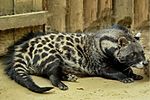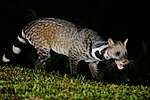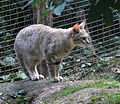The African civet (Civettictis civetta) is a large viverrid native to sub-Saharan Africa, where it is considered common and widely distributed in woodlands...
28 KB (2,946 words) - 10:25, 18 August 2024
Viverridae. It is also used to refer to the African palm civet and the Malagasy civet. The African palm civet (Nandinia binotata) is genetically distinct...
14 KB (1,582 words) - 09:28, 17 September 2024
African palm civet (Nandinia binotata), also known as the two-spotted palm civet, is a small feliform mammal widely distributed in sub-Saharan Africa...
15 KB (1,717 words) - 15:42, 1 August 2024
civet oil in their perineal glands, including the African civet (Civettictis civetta), large Indian civet (Viverra zibetha), and small Indian civet (Viverricula...
6 KB (577 words) - 11:29, 28 September 2023
The Asian palm civet (Paradoxurus hermaphroditus), also called common palm civet, toddy cat and musang, is a viverrid native to South and Southeast Asia...
20 KB (2,214 words) - 06:12, 23 June 2024
relatively large civet, almost certainly the largest of the Viverra species and exceeded in size among the Viverridae family only by African civets and binturongs...
9 KB (1,023 words) - 02:45, 18 March 2024
The Malagasy or striped civet (Fossa fossana), also known as the fanaloka (Malagasy, [fə̥ˈnaluk]) or jabady, is an euplerid endemic to Madagascar. It...
10 KB (1,053 words) - 11:13, 13 April 2024
Aardwolf (redirect from Civet hyena)
termite-eating hyena and civet hyena, based on its habit of secreting substances from its anal gland, a characteristic shared with the African civet. Unlike many...
25 KB (2,848 words) - 11:34, 19 September 2024
contains the extant African civet (Civettictis civetta) and a recently described extinct relative from the Plio-Pleistocene of South Africa known as Civettictis...
3 KB (209 words) - 16:10, 10 July 2024
000 years ago, with the North African/Near Eastern wildcat splitting from the Asiatic wildcat and the Southern African wildcat about 131,000 years ago...
31 KB (3,297 words) - 03:02, 19 September 2024
The small Indian civet (Viverricula indica) is a civet native to South and Southeast Asia. It is listed as Least Concern on the IUCN Red List because...
28 KB (2,787 words) - 16:03, 10 July 2024
The masked palm civet (Paguma larvata), also called the gem-faced civet or Himalayan palm civet, is a viverrid species native to the Indian subcontinent...
17 KB (1,745 words) - 15:27, 10 July 2024
Civetone (redirect from Synthetic civet)
macrocyclic ketone and the main odorous constituent of civet oil. It is a pheromone sourced from the African civet. It has a strong musky odor that becomes pleasant...
4 KB (251 words) - 00:46, 21 September 2023
The African leopard (Panthera pardus pardus) is the nominate subspecies of the leopard, native to many countries in Africa. It is widely distributed in...
34 KB (3,648 words) - 14:01, 18 September 2024
wide variety of "musky" substances from other animals such as the African civet ("civet musk") or various synthetic musks whose compound exhibits some character...
7 KB (882 words) - 13:09, 10 May 2024
The Malayan civet (Viverra tangalunga), also known as the Malay civet and Oriental civet, is a viverrid native to the Malay Peninsula and the islands of...
9 KB (975 words) - 05:50, 4 March 2024
The Malabar large-spotted civet (Viverra civettina), also known as the Malabar civet, is a viverrid endemic to the Western Ghats of India. It is listed...
10 KB (1,193 words) - 06:56, 21 June 2024
diet. Family Nandiniidae (the African palm civet) has only one species (Nandinia binotata), extant across sub-Saharan Africa. They have retractile claws...
22 KB (2,185 words) - 00:11, 17 September 2024
The otter civet (Cynogale bennettii) is a semiaquatic viverrid native to Thailand, Malaysia, Indonesia and Brunei. It is believed to be undergoing severe...
7 KB (639 words) - 05:49, 15 April 2024
Viverridae, but is a member of the Eupleridae. The African palm civet (Nandinia binotata) resembles the civets of the Viverridae, but is genetically distinct...
38 KB (2,338 words) - 11:15, 5 August 2024
The African wild dog (Lycaon pictus), also known as the painted dog or Cape hunting dog, is a wild canine native to sub-Saharan Africa. It is the largest...
73 KB (8,056 words) - 04:52, 31 August 2024
Paradoxurus (redirect from Southern palm civet)
Paradoxurus is a genus of three palm civets within the viverrid family that was denominated and first described by Frédéric Cuvier in 1822. The Paradoxurus...
7 KB (710 words) - 07:52, 20 May 2024
The African wolf (see below for other names; Canis lupaster) is a canine native to North Africa, West Africa, the Sahel, northern East Africa, and the...
66 KB (7,005 words) - 07:37, 5 September 2024
CIVETS is an acronym for six emerging market countries identified for their rapid economic development: Colombia, Indonesia, Vietnam, Egypt, Turkey, and...
12 KB (964 words) - 22:11, 6 April 2024
The Sulawesi palm civet (Macrogalidia musschenbroekii), also known as Sulawesi civet, musang and brown palm civet is a little-known viverrid endemic to...
6 KB (708 words) - 23:52, 18 July 2024
Palm civet is the common name of several species of feliform carnivorans in two families. Family Nandiniidae: African palm civet (Nandinia binotata) Family...
770 bytes (115 words) - 22:53, 17 January 2024
Mongoose (category Mammals of Africa)
closely related to Madagascar carnivores, including the fossa and Malagasy civet. Galidiinae is considered a subfamily of Eupleridae. Phylogenetic research...
39 KB (2,741 words) - 21:17, 4 September 2024
range in size from the African linsang with a body length of 33 cm (13 in) and a weight of 650 g (1.43 lb) to the African civet at 84 cm (33 in) and 18 kg...
14 KB (1,333 words) - 16:08, 10 July 2024
The golden palm civet (Paradoxurus zeylonensis) is a viverrid endemic to Sri Lanka. It is listed as Vulnerable on the IUCN Red List. Its distribution...
9 KB (914 words) - 06:57, 11 August 2024
with the Malagasy species being in their own family Eupleridae. The African palm civet is a basal cat-like carnivoran. The linsang is more closely related...
46 KB (4,423 words) - 19:24, 16 September 2024




























